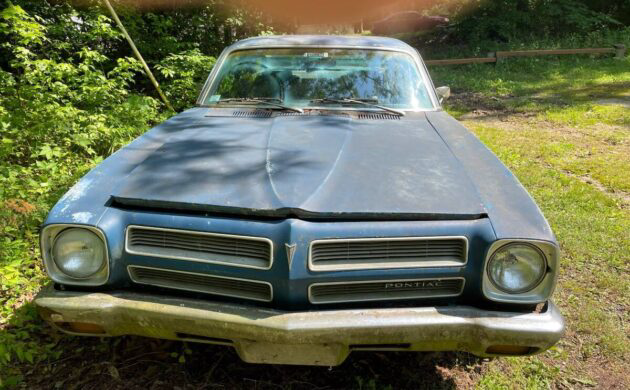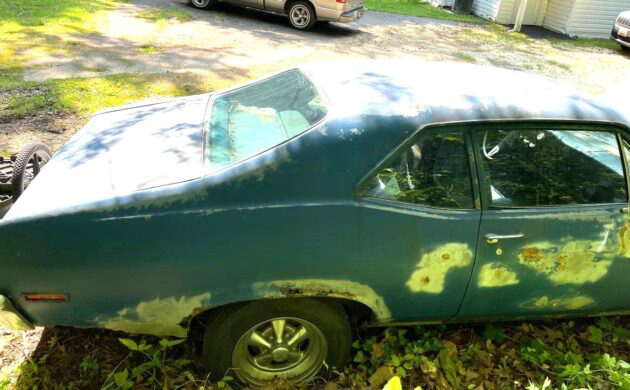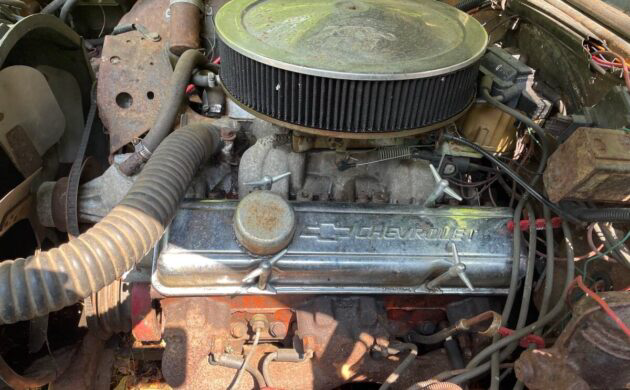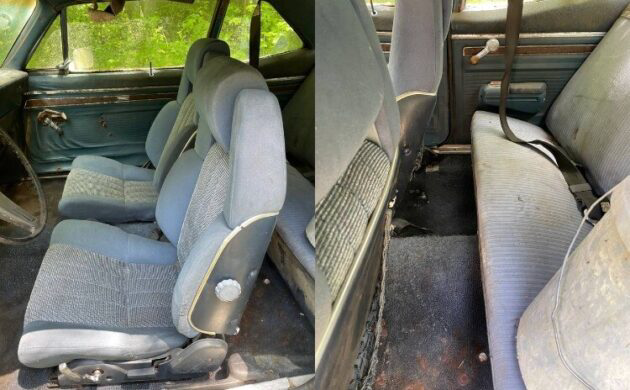The Ventura nameplate first appeared as a trim option on the Pontiac Catalina in 1960. But a little over a decade later, the company changed gears and assigned it to a “new” compact, the Ventura II, which was a not cleverly disguised, badge-engineered Chevy Nova. This 1972 edition has seen better days, its running condition is unknown, and rust has already tried to get a foothold. Located in Leonardtown, Maryland, this interesting project with a Chevy V8 is available here on craigslist for $2.500 as a tip by Barn Finder Mitchell G.!
Given the increased U.S. interest in smaller cars in the 1960s, it’s interesting that Pontiac didn’t have a compact after 1963. In 1964, the Tempest was promoted to a mid-size automobile and gained the GTO in the process, which no doubt kept Pontiac bean counters happy for a while. But that changed in 1971 when Pontiac began selling their version of a Chevy Nova, which differed mainly by the tip of the front clip, hood, and rear taillights. As to not confuse it with the Ventura version of the Catalina which had been sold just the year before, it became the Ventura II (then just Ventura again in 1973)
The Ventura II sold in much smaller quantities than the Nova. For example, while in 1972 Chevrolet built nearly 350,000 Novas, the Ventura II saw a quarter of that, or 72,000 copies. And two-thirds of those, or 51,000 units, were the 2-door sedan or coupe like the seller’s car. There was no performance version of the Ventura II like the Nova SS. This is interesting because Chrysler wasn’t shy in that sector with the Plymouth Duster 340 and Dodge Demon 340.
This Pontiac is trying extra hard to be the Chevrolet it’s fashioned after. Under the hood lies a V8 engine which has Chevy-branded chrome valve covers attached to what we think is a 350 cubic incher, yet Pontiac offered its own 350 V8 in the Ventura at the time. So, we’re guessing the original motor went south at some point and this substitute was readily available. Does it run? We don’t know as the seller doesn’t get into many details. Did the automatic transmission change at that time, too? Good question.
Some attempts to stop the invasion of rust have occurred with body filler present in both of the rear quarter panels and doors. But what could be the original blue paint has given all it can and needs repainting after you fix the body (big job?). The interior will need some help, where the original front bench seat is gone in favor of two buckets seats from a different kind of car. The upholstery almost matches the back seat, but not quite. And we see aftermarket air conditioning under the dash, but not the hood. Cragar mag wheels round out the package, so this “Nova” was at least intended to look fast in its heyday. Are you in at the seller’s low asking price?







I like this car
Apparently you could clone it into a rusty nova or a rusty GTO, so thats a plus
The Chevrolet 307 V8 was an option on this car, with the Chevrolet 250 inline 6 being the base engine. Many people believe 1977 was the year that GM began installing other divisions engines (i.e. Buick V6 in Oldsmobiles, Pontiac 301’s in Buicks, etc) in other makes, but I believe 1971 was the first year a Chevrolet engine could come in a Pontiac.
Believe it or not, the rear quarters are different. Why they made such a subtle difference is beyond me, but they also did it with the 78 Lemans and Malibu 2 door models
Now as far as I know they know the quarters are the same, tailights are longer versions of the nova tailights but qtrs are the same, I know because I bought goodmark nova replacements and welded them onto my car.
It likely had a Chevy 307 in it, or still does. The turbo 350 Chevy transmission mounts differently than the BOP Turbo 350, so its all Chevy here
My mother owned one in the early seventies. Had a 350 engine and was an absolute rocket under heavy acceleration.
She also followed it with what I believe was known as an Oldsmobile Omega, basically the same car but with a smaller engine.
Both cars were upscale Novas, nothing more.
The Chevy 2 became the Nova, then Olds got the Omega, Pontiac got the Ventura, and Buick got the Apollo. The spinoff order spelled N O V A. I had a 1977 Omega with the emissions minded (slow) Chevy 305. This car is no better or worse than its brethren. However I have no need to relive the 70’s so I’ll pass on this.
Hah!, When I was younger, I would of been all over a project like this, but too much work, for a car that I believe is not very desirable, or valuable. With that said, more power to whoever can keep it from rusting into oblivion!